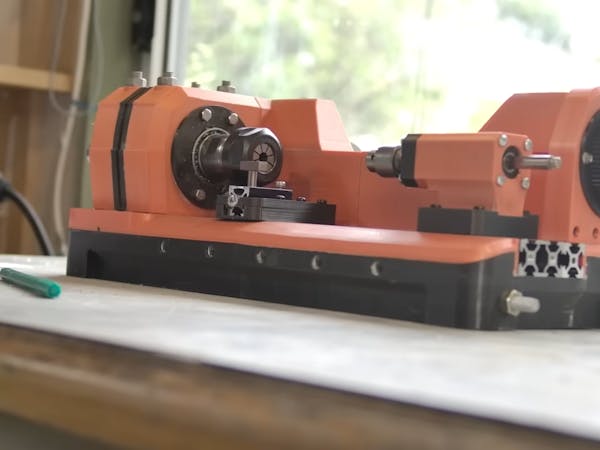Machine tools are expensive. Cutting metal, even relatively soft metals like aluminum, requires a very rigid frame. Because the economics of physics and market forces are real, manufacturers use hundreds or even thousands of pounds of heavy iron (or steel, if you’re high-end) to achieve that stiffness. The cost of the materials alone, plus the shipping costs for all of its weight, can quickly add up to a significant amount, and that’s before you even get to the actual precision manufacturing or control electronics. But Chris Borge found an inexpensive workaround that allowed him to design this DIY metalworking lathe that costs about $100 to build.
The Open Lathe V1 is one of a series of machines designed by Borge. All of this series takes advantage of the advantages of poured concrete and achieves high rigidity at low cost. The idea of using concrete for machine tool frames is not new. It seems to pop up every few decades and then become less noticeable again. This is probably due to the complexity involved in creating the formwork for the builder to pour the concrete into. From there, Borge’s design philosophy really began to attract attention. His machine uses 3D printed foam that can be manufactured by anyone with a basic 3D printer.
This is Borge’s second attempt at designing a lathe built in this manner. The first one worked, but was difficult to build, had poor performance, and had obvious spindle deflection in the video even under relatively light loads. This new design seems to solve both of these problems and perform very well.
The beauty of this design is how the formwork (a hollow 3D printed container to hold the concrete) holds other parts, such as the spindle mount, in place while the concrete dries. These complex shapes are virtually impossible to manufacture without 3D printing, but they are now almost effortless using hobby printer models. After the concrete is completely dry, the formwork remains to give the lathe a beautiful appearance.
Borge estimates the machine will cost between 100 and 150 Australian dollars (approximately 66 and 100 US dollars) to build, depending on the filament, concrete, non-printable parts such as the tailstock, and the motor. Complete BoM and build tutorials are not yet available (Borge is working on them), but the STL files are already on Printables.
Of course, this is not a high-precision machine and may not satisfy machinists with thousands (or tens of thousands of dollars) of lathes, but it is very affordable and will meet the needs of most hobbyists. should be sufficient.

